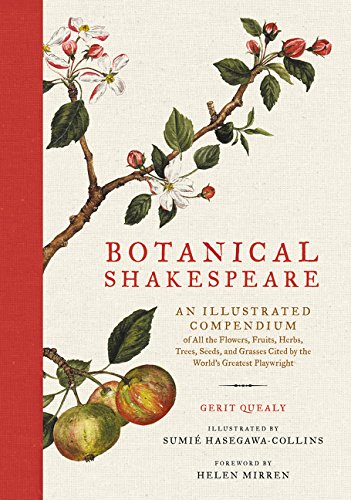Portraits of the over 170 flowers, fruits, grains, grasses, trees, herbs, seeds and vegetables that are named in Shakespeare’s poems and plays
Sumié Hasegawa (Artist), Foreword by Helen Mirren
“It’s the experience of each plant that provides the thrill!” ~Helen Mirren
Shakespeare expert Gerit Quealy collaborated with notable Japanese artist Sumié Hasegawa to create the most complete collection of plant life featured in the playwright’s works, BOTANICAL SHAKESPEARE (Harper Design; On Sale: April 4, 2017; Hardcover; $22.99/$28.50 CAN; 208 pages; ISBN: 9780062469892). This stunning compilation, which includes the first-ever foreword contributed by Helen Mirren, is an homage to the specific flora that populates the beloved writer’s art.
BOTANICAL SHAKESPEARE begins with a brief look at Shakespeare’s world and the flowering of ‘green desire’. The author and artist reveal Shakespeare’s keen awareness of botany alongside his unparalleled ability to catapult nature into the land of emotion and metaphor, creating some of the world’s most unforgettable passages. Quealy and Hasegawa provide portraits of the over 170 flowers, fruits, grains, grasses, trees, herbs, seeds and vegetables that are named in Shakespeare’s poems and plays alongside all the lines in which they appear—something never before done. BOTANICAL SHAKESPEARE’s evocative color illustrations are further enhanced by identification of the specific work in which each line appears, as well as the character who says it. The elegant typefaces and meticulous arrangement of plants and quotes throughout the book mirror the richness of Shakespeare’s writing.
This compendium also includes a dictionary revealing unique aspects of each plant—such as Eglantine, a wild rose with a slight prickle, beloved for its singular scent superior to any other rose, or why in some cases, actually seeing the plant crystalizes the line. Plus, several long-standing Shakespeare botanical mysteries are reexamined, and even solved, including…
The 4 Secrets / “discoveries” in Botanical Shakespeare
The truth about Peonies
What’s the poison in Hamlet?
Medlar & the “fruit” epithet
*A 400-year old mistake about the Caraway corrected!
Ms. Quealy also discovered that the rose quotes themselves from all 8 War of the Roses plays tell the story of the War of the Roses! So she along with British director Jenny Eastop have fashioned a 10-minute play from just the quotes. (Ms. Quealy has also discovered a letter from Philip Herbert, one of the ‘Incomparable Paire of brethren’ to whom Shakespeare’s First Folio is dedicated, in Herbert’s own handwriting. Her paleographic essay will be published in the Sroing 2017 issue of the respected Sidney Journal. Related although not directly impacting the book per se but a testament to her wide-ranging research skills).
BOTANICAL SHAKESPEARE is perfect for nature lovers, Shakespeare enthusiasts, passionate gardeners, quote connoisseurs, and those looking for a thoughtful and unique Mother’s Day or Father’s Day gift, this book offers depth and insight into Shakespeare and his timeless art through the distinct perspective of the plants he venerated.
Gerit Quealy (Author & Editor) is a journalist, author and editor living in New York City. She has been invited to speak at a wide range of organizations around the world including Columbia University, Williams College, and Shakespeare’s Globe, London, leading workshops for actors and laymen alike. She began her career as an actor on ABC’s Ryan’s Hope, and alongside Robert Sean Leonard in Romeo & Juliet, but fell in love with paleography, honing her skills at the Folger Institute in Washington, DC. She has been published both academically and in mainstream outlets including the New York Times, Huffington Post, Modern Bride, Woman’s Day, as well as several years spent writing extensively for Country Living Gardener and other gardening publications.
Born and raised in Japan, Sumié Hasegawa (Artist) completed her studies at the Art Women’s College of Japan in Tokyo, where she received an award for graphic design. She also won a prize in Japan’s national Package Design Competition while employed at the Kakune Design Office in Tokyo. Sumié spent over two decades researching and executing this work. She currently lives with her husband, Fred Collins, in New Jersey, where she has taught flower arrangement, design craft, and painting.


